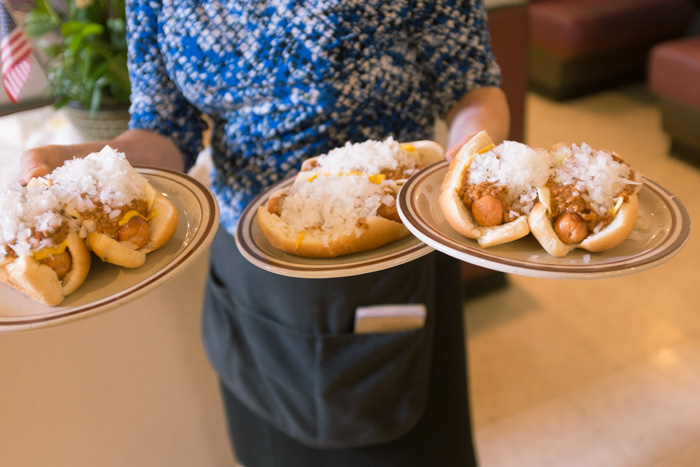Hold the Fries!

Photo by Carl Socolow '77.
Students investigate how local restaurants could battle childhood obesity
by MaryAlice Bitts-Jackson
With their smaller portions and prices and comfortingly familiar fare, children’s menus are budget- and kid-friendly. And at a time when the average American spends more at restaurants than on groceries, they play a larger part in our children’s national diets than ever before.
So Partnership for Better Health, a regional public-health foundation, wanted to know: Could healthier children’s menus aid in the battle against childhood obesity? Students in Associate Professor of Psychology Sharon Kingston’s fall health-studies seminar were on the case, and they presented their findings and recommendations to community leaders on Dec. 9. The student-researchers divided into three groups and examined interrelated factors in local children’s food choices.
Menus by the numbers
The students in the menu-analysis group used a point system to evaluate children’s fare at 20 locally owned restaurants. Restaurants that did not include sugary drinks and dessert in kids’ entrees earned a point; fresh produce on the kids’ menu garnered two.
Many of the same foods appeared on the children’s menus. The most popular items—chicken fingers, pancakes, mac ‘n cheese, fries and applesauce—were high in calories, fat and/or sugar. Healthier side options, like a small salad, were sometimes available, but with an extra fee.
“We were surprised to learn that most of the restaurants didn’t have fresh produce on the children’s menu,” said Layla Budin ’17 (biology), adding that the four restaurants that earned top marks on this scale were Horner’s Corner, Vinny’s, Aya Steakhouse and Issei Noodle. “And while the [main] menus included lighter options, the children’s menus typically did not.”
The chef’s POV
The second research team probed the decisions behind the entrees by interviewing chefs at 12 local pizzerias, diners, pubs and fine-dining establishments. They discussed each restaurant’s customer base, profit margin, food sources and influence in the local dining culture, as determined by business longevity (the oldest restaurant they surveyed was established in 1928; the youngest, 2014). They also noted whether the chefs had had formal culinary or nutritional training.
Investigating why local children’s menus are so similar, the students learned that about 44 percent of the surveyed restaurants bought ingredients, equipment and/or prepared foods from the same national supplier. Recurring menu items were also safe bets, reflecting broad national tastes, and inexpensive.
“And with narrow profit margins at these restaurants,” Jonathan Legregin ’17 (neuroscience), “it’s hard to justify spending a lot of money on fresh produce if it’s not eaten, and you just have to throw it away.”
Asked whether they felt their food influenced local childhood-obesity rates, “many chefs felt that change needs to happen within the family first,” said Steven Foster ’17 (anthropology). “If there is no pressure from the adults in your life to eat in a healthy way at home, then there is no pressure to eat healthy in a restaurant, especially since people often aren’t worried about what they eat at a restaurant—they see it as a treat.”
The exception: Chefs at the higher-end establishments had higher levels of formal education in the field and expressed higher motivation to offer children healthier choices. The problem? Because of higher prices, they were unlikely to influence eating habits among low-income children—those most at-risk for obesity.
Nutritional legacies
The third team went to the source of at-risk children’s food choices by interviewing low-income mothers enrolled in special programs at the Carlisle YWCA and Hope Station.
“Price is a deciding factor for these working mothers, and they are also pressed for time,” said Nalani Saito ’17 (anthropology). “There seems to be a contrast between what is healthy for your family and what is inexpensive and convenient, since many of them said that the community does not offer healthy, low-cost food. These mothers are between a rock and a hard place.”
Exacerbating the issue: Children whose parents fall behind on school-lunch payments are fed cheese sandwiches—not enough, the mothers said, to keep them satisfied throughout the day, particularly when they had early lunch periods. Mothers coming home from work may feel they don’t have time to prepare meals for these very hungry children. Many see drive-throughs as a solution.
“The words ‘willpower’ and ‘self-control’ kept coming up. They blamed themselves” for their children’s poor diets, said Danielle Melnick ’17 (women’s, gender & sexuality studies). “They also said that their kids would get a salad if there was a salad bar at the restaurant, but that they wouldn’t pay $7 for a salad that wouldn’t fill them up.”
The verdict
The students offered several approaches to this complex problem. They recommended that local restaurants “eliminate or radically redefine” children’s menus across the board, giving child diners the same breadth of choices as the adults, but with smaller portions and prices. They also advocated for salad bars, surcharge-free, healthy side options and larger portion sizes for lighter dishes.
They also suggested that local nonprofits offer meal-prep and nutrition classes for low-income parents and children, and special initiatives, like a crock-pot giveaway and a community cookbook, compiling healthy and time-saving recipes. And to better understand the interconnected issues of local dining and childhood obesity, they recommended further study into local restaurant sourcing and school-lunch/school-snack reform.
“When I first came up with the seed of this study, I thought it would be an easy fix, but your project has shown me that there’s much more to the issue than I realized,” said Becca Raley, executive director of Partnership for Better Health, after the students' presentations. “Your thoughtful analysis is giving us low-hanging fruit, and I’m grateful to you all.”
Learn more
- Health Studies Program
- Food Studies Program
- “Studying Stigma”
- “Fresh Perspectives”
- Civic Engagement at Dickinson
- Latest News
Published December 14, 2016